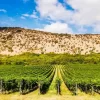Viticulture, a rich and captivating tradition, has developed various practices over centuries to enhance grape quality and produce exceptional raw materials. Which, of course, has to be “turned into” wine. Understanding the fundamentals of viticulture is crucial to appreciating the applied techniques in conventional, organic, and biodynamic winemaking.
Simplified, the primary goal of viticulture is to achieve maximum yield in proportion to quality. The contemporary viticulture landscape encompasses diverse approaches, considering factors like worldview, ethical concerns, production goals, intended wine quality, cost, labour availability, and environmental impact.
One could say conventional viticulture has a generic approach or poses challenges in its precise definition due to the absence of a legal framework. Compared to certified organic or biodynamic viticulture. Everything goes as long as it is not forbidden. Organic- and biodynamic viticulture has a legal (or at least a narrow personal interpretation) framework. I would summarize it as the following: organic viticulture looks down to the ground, and biodynamic looks up to the sky.
Conventional viticulture: favouring reliable and regular harvests?
Efficiency and technology-oriented conventional viticulture still face regulations, particularly regarding pesticide residues. Maximum Residue Limits (MRLs) set by governments and international bodies ensure safe concentrations of residues in grapes and wine. Adherence to MRLs is crucial for food safety compliance. And various methods, including liquid chromatography-tandem mass spectrometry, monitor pesticide residues in wine. Throughout the 20th century, exploitative soil use prevailed, accelerating with mechanization, increased irrigation, and chemical fertilizer use. While intensifying agriculture ensured global production, it also risked degrading soil and water resources in vineyards.
Conventional wisdom: integrated pest management & co.
Integrated pest management (IPM), a precursor to organic viticulture, is emerging, with a shift towards sustainable practices considering economic, social, and ecological sustainability. Conventional viticulture focuses on economic and technical efficiency, allowing practices not forbidden by laws or regulations. Differences lie in areas such as pest control and soil management, offering advantages like vineyard mechanization and tailored care for specific grape varieties.
Organic viticulture is on the rise
The International Organisation of Vine and Wine (OIV) points to a global shift towards organic viticulture. In 2019, approximately 6.2% of the global vineyard area (454,000 hectares) practised organic viticulture in 63 countries. The transition from conventional to organic vineyards accelerated, with a significant increase in certified organic vineyard areas from 2005 to 2019. At the core of organic farming lies a profound emphasis on soil health. Organic farmers prioritize creating and maintaining a robust soil ecosystem. Advocates argue that soils rich in organic matter can effectively store inorganic mineral ions necessary for healthy plant growth. Additionally, they provide complex nutrients at a slower pace, proving more beneficial for optimal vine growth compared to the rapid delivery of inorganic fertilizers. Soil is a crucial factor in organic viticulture.
The difference in the detail
Unlike conventional viticulture, where synthetic fertilizers (e.g., ammonium nitrate) may be used, they are prohibited in organic farming. Therefore, compost is often employed. Soil and bloom analyses can identify nutrient deficiencies, and organic nitrogen, obtained from composting grape skins, seeds, and stems, can be utilized. Organic viticulture experiences approximately 20% lower yields, contributing to enhanced quality but with about 20% higher costs. Small winegrowers often find it easier to transition to organic cultivation as they don’t have to forgo the scale advantages that large conventional growers enjoy.
Looking down, the soil
In organic viticulture, soil improvement is a focus, increasing the diversity of microorganisms and animals in the vineyard, such as earthworms. Promoting the health and disease resistance of the vines is crucial. Effective soil work and canopy management are part of the farmer’s repertoire. The use of artificial fertilizers, fungicides, herbicides, and pesticides is largely rejected. Prominent features include the application of biodegradable compost, natural fertilizers, and the promotion of cover crops to prevent soil erosion and support soil life. Moreover, monoculture in vineyards is also discouraged, fostering biodiversity. Various certificates and responsible authorities for organic viticulture exist worldwide, with specifications potentially varying while adhering to the same fundamental principles.
Looking up -biodynamic principles
The older cousin of organic farming is biodynamic farming, which Austrian philosopher Rudolf Steiner introduced in 1924. This agricultural system is based on biodiversity, the lunar calendar, and the holistic idea of the farm as a symbiotic unit. According to Nicolas Joly, “bio” is short for “life,” and “dynamic” means “enrichment, acceleration, or stimulation of life.”
Many scientists encounter challenges when dealing with biodynamic agriculture. While some biodynamic practices are scientifically explainable, such as the use of cover crops and the emphasis on soil health, other aspects of biodynamic practices may appear peculiar. The biodynamic calendar includes astrological elements, some preparations (mixtures of plant and animal materials, often fermented and applied to soils, vines, and compost) are unique, and the dynamization of these preparations through specific stirring techniques may seem dubious. The biodynamically cultivated vineyard area is roughly 22,515 hectares, according to statistics from the American Association of Wine Economics (AAWE).
Summary
Particularly organic and biodynamic viticulture, illustrates the complex dynamics existing in the world of grape cultivation. While the conventional approach relies on proven methods and technologies, often enabling efficient mass production. The organic and biodynamic approaches demonstrate an increasing emphasis on sustainable practices, biodiversity conservation, and respect for natural cycles. The challenge lies not only in minimizing the ecological footprint but also in finding a balanced harmony between ecological responsibility and economic profitability. The debate on the best way to produce high-quality grapes while simultaneously protecting the environment remains highly relevant. Given the rising demand for sustainable products, organic and biodynamic viticulture opens new perspectives for both winemakers and consumers alike.







